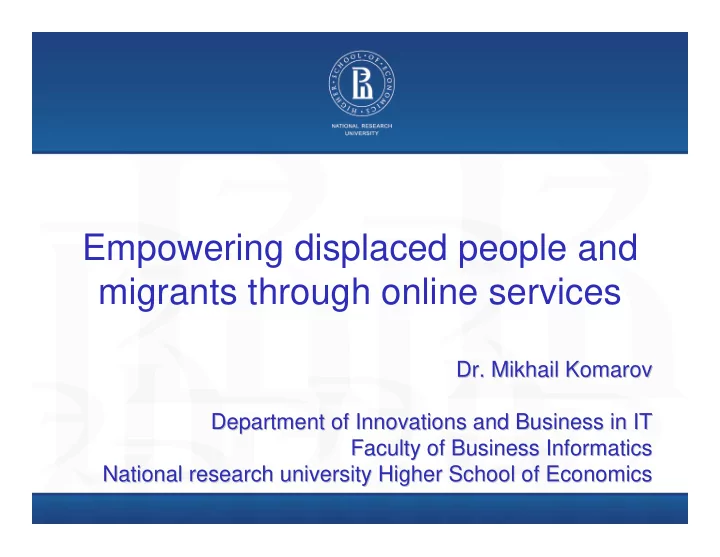

Empowering displaced people and migrants through online services Dr. Mikhail Komarov Dr. Mikhail Komarov Department of Innovations and Business in IT Department of Innovations and Business in IT Faculty of Business Informatics Faculty of Business Informatics National research university Higher School of Economics National research university Higher School of Economics
Программная инженерия Introduction Introduction photo Economical development – technical progress. What history tells us: • GSM and mobile networks – 1946 • Internet – (idea by DARPA – 1957) – 1969 photo • Social Networks – let’s say the Facebook – 2004 • Mobile applications networks etc. – 2010 photo M. Zuckerberg: “We’re going to execute this mission to make the world connected and build value over the long-term. The bigger question that will define how we’ve done is how we do with mobile” photo 2
Программная инженерия Introduction Introduction photo Refugees in Uganda are using SMS and cellphones to reconnect with family members and close friends. Photo via MobileActive - Fukushima(AFP photo) - Syrian refugee camp on the Turkish border for displaced people of the Syrian civil war. photo (Henry Ridgwell of Voice of America) Deputy UN High Commissioner for Refugees Alexander Aleinikoff provides an introduction to the special issue: “ Superficially at least, today’s refugee camps do not appear photo significantly different from those that existed 30 or 40 years ago. Modernisation seems to have passed them by. But upon a closer look, it becomes apparent that things are changing. Today, refugees and IDPs in the poorest of countries often have access to a mobile phone and are able to watch satellite TV. Internet cafés have sprung up in some settlements, the hardware purchased by refugee entrepreneurs or donated by photo humanitarian organisations such as UNHCR. And aid agencies themselves are increasingly making use of advanced technology: geographic information systems, Skype, biometric databases and Google Earth, to give just a few examples. ” 3
Программная инженерия Introduction Introduction photo Web 3.0 - ? � Web 1.0, or the information web, was straightforward enough. This version of the web was able to provide information to users in a broadcast model of information distribution. � The next evolution of the web brought about Web 2.0 or the social web which is characterized by users communications, contributing and collaborating. � Web 3.0 means that our things, our belongings will have the power to learn, intuit and photo decide. photo photo 4
Internet of Services Internet of Services photo • To be able to provide services through the Internet • To be able to integrate services through the Internet • To be able to utilize services through the Internet photo • Service oriented architecture • Event-driven architecture photo • All together – data-driven architecture photo 5
Программная инженерия Internet of Services – – user Internet of Services user- -oriented level oriented level photo photo photo photo 6
Программная инженерия Internet of Services – – governmental level Internet of Services governmental level photo • Policy-making applications and services (crowd-based platform etc.). • Educational services (signing for the education, education for far-located villages and towns etc.). • Culture and traditions – oriented applications and services (local rules and policies, local culture etc.). • Medical applications and services (far-located villages and refugee camps etc.). • Banking applications and services (remote banking, e- payments etc.). • Information-support applications and service (connection with relatives, news-terminals etc.). 7
Программная инженерия Internet of Services Internet of Services photo • Data-driven. • Personalized. • Web-oriented. • Future business models for the Internet of Services will focus photo on partnership, providing services through business networks (value added by the 3rd party). photo photo 8
Программная инженерия Challenges Challenges photo • Which services should be provided for free? • Who should develop services and who should support development: government, business, intergovernmental organizations? • Which services should be country-independent, which should be focused on a local communities? • Facilities – who will guarantee services and who will provide them? • Basic requirements for the implementation? 9
If you have any questions, please do not hesitate contacting me: Dr. Mikhail Komarov mkomarov@hse.ru
Recommend
More recommend